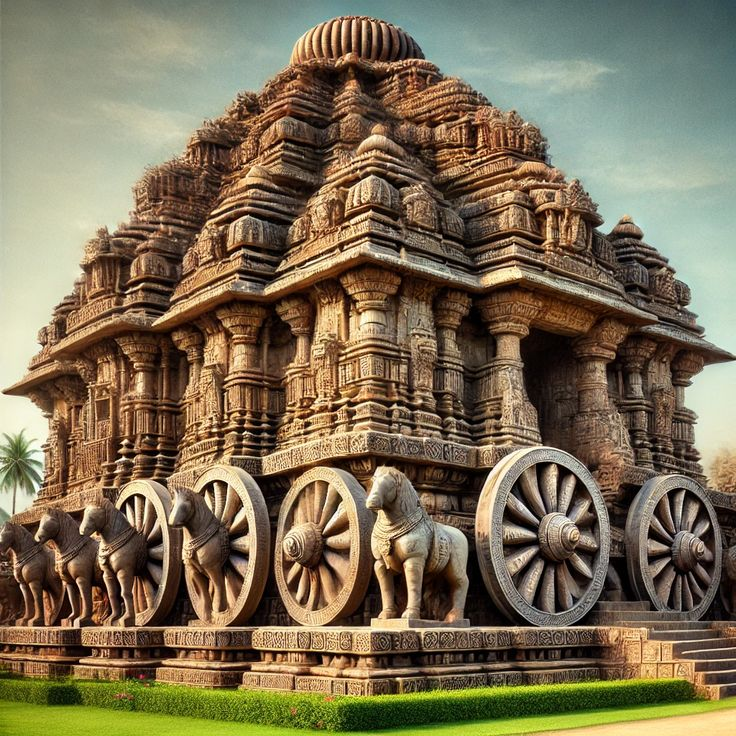Important Facts For Prelims
Konark Wheels at Rashtrapati Bhavan
- 11 Nov 2024
- 5 min read
Why in News?
Recently, four sandstone replicas of the iconic Konark wheels from the Konark Temple have been installed at the Rashtrapati Bhavan’s Cultural Centre and Amrit Udyan. This initiative is among various efforts to incorporate traditional cultural and historical elements into Rashtrapati Bhavan.
- Konark temple was declared a UNESCO world heritage site in 1984. It is built in odisha school of temple architecture.
Odisha School of Temple Architecture
- It is a sub-schools of Nagara School of architecture and comes under East Indian Temples.
- The main architectural features of Odisha temples are classified into three orders, i.e., rekhapida, pidhadeul and khakra.
- Most of the main temple sites are located in ancient Kalinga—modern Puri District, including Bhubaneswar or ancient Tribhuvanesvara, Puri and Konark.
- In general, the shikhara, called deul in Odisha, is vertical almost until the top when it suddenly curves sharply inwards.
- Deuls are preceded, as usual, by mandapas called jagamohana in Odisha.
- Odisha temples usually have boundary walls.
- The ground plan of the main temple is almost always square, which, in the upper reaches of its superstructure, becomes circular in the crowning mastaka.
- Compartments and niches are generally square, the exterior of the temples are lavishly carved, their interiors generally quite bare.
What is are Key Facts and Significance of the Konark Sun Temple?
- About Konark Temple:
- The 13th-century Konark Sun Temple, near Puri in Odisha, was built by King Narasimhadeva I (1238–1264 AD). Its grand scale and intricate design symbolise the strength and cultural values of the Eastern Ganga Empire.
- The Eastern Ganga dynasty also known as Rudhi Gangas or Prachya Gangas.
- It was a major Indian royal dynasty that ruled Kalinga from the 5th to early 15th century.
- Key Features of Temple:
- The vimana (principal sanctuary) was surmounted by a high tower with a shikhara (crowning cap) also known as Rekha deul, which was razed in the 19th century.
- To the east, the jahamogana (audience hall or Mandap) dominates the ruins with its pyramidal mass.
- Farther to the east, the natmandir (dance hall), today unroofed, rises on a high platform.
- The 13th-century Konark Sun Temple, near Puri in Odisha, was built by King Narasimhadeva I (1238–1264 AD). Its grand scale and intricate design symbolise the strength and cultural values of the Eastern Ganga Empire.
- Architectural Significance:
- Chariot Design: Temple is shaped as a colossal chariot with 7 horses symbolising the days of the week and 24 wheels representing 24 hours in a day.
- Wheel Construction: Each wheel, 9 feet 9 inches in diameter, has 8 thick and 8 thin spokes, serving as ancient sundials.
- The intricate carvings include circular medallions, animals, and foliage on the rims, as well as luxury scenes within the medallions.
- Symbolic Elements: The 12 pairs of wheels signify the months of the year, while some interpretations relate the wheel to the ‘Wheel of Life’—the cycle of creation, preservation, and realization.
- Cultural Heritage:
- Dharma and Karma: The Konark Wheel is akin to the Buddhist Dharmachakra, symbolising the cosmic cycle of Dharma (righteousness) and Karma (action).
- Zodiac Representation: Another interpretation suggests the 12 wheels represent the zodiac signs, linking it to astrological and cosmic principles.
- Sundial Functionality:
- Time Measurement: Two of the wheels can determine the time from sunrise to sunset.
- Spoke Arrangement: Wider spokes denote 3-hour intervals, thinner spokes represent 1.5-hour periods, and beads between spokes mark 3-minute increments.
- Midnight Mark: The top center wider spoke symbolizes midnight, with the dial moving anti-clockwise to display time.
UPSC Civil Services Examination, Previous Year Question (PYQ)
Prelims
Q. The Nagara, the Dravida and the Vesara are the (2012)
(a) three main racial groups of the Indian subcontinent
(b) three main linguistic divisions into which the languages of India can be classified
(c) three main styles of Indian temple architecture
(d) three main musical Gharanas prevalent in India
Ans: (c)





